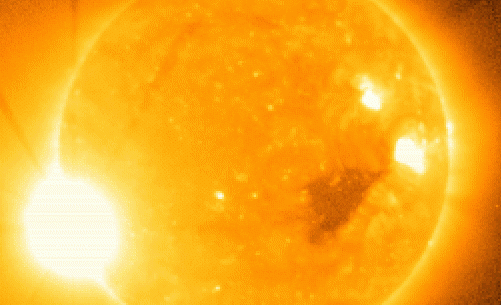Podcast: Play in new window | Download
Subscribe: RSS

A solar flare recorded Dec. 5, 2006, by the X-ray Imager onboard NOAA's GOES-13 satellite. The flare was so intense, it actually damaged the instrument that took the picture.
Blind faith in the power of industrial technology to provide everyone with cheap luxury requires turning a blind eye to the deferred costs of industrialization. And the longer we ignore the consequences, the worse they are. For example, the longer we tolerate industrial agriculture’s loss of topsoil, pollution of water and destruction of diversity, the more difficult will be any recovery to sustainable practices. Our society remains stubbornly oblivious to even the obvious rising threats; but here’s one that, real as it is, is truly obscure: the possibility that the sun could turn off our lights. (To listen to the audio version, click here: 0103 Solar Powered Blackout)
The nature of the threat, and the history of its prior manifestations, was outlined in a blog entry two years ago by Dr, Jeff Masters, meteorologist and co-founder of the Weather Underground website. Solar flares on the surface of the sun can result in the bombardment of earth by charged particles (some of which announce their arrival by setting off the aurora Borealis, or northern lights) that create a geomagnetic storm on earth. Usually, the effects of these storms on civilization are negligible, but there have been exceptions, and a future event could bring the industrial world to its knees.
The strongest solar storm in recorded history occurred on September 2, 1859. Actually, that’s the date the recorded history of solar flares began, because until this event was spotted and recorded by the British astronomer Richard Carrington, we did not know about them. The effects of the extremely powerful Carrington Event, as it came to be known, were limited to some wild pyrotechnics in the telegraph system, caused by induced electrical currents in the wires, that shot sparks from keys, shocked operators and set some small fires; and an eruption of auroras over the entire Northern Hemisphere that turned night to day. (Some confused campers in the Rocky Mountains got up shortly after midnight and began cooking their breakfast, thinking it was dawn.)
However, the more dependent a society becomes on long wires, electronics and satellites, the more vulnerable it becomes to solar flares. Fortunately, in the 160 years since Carrington (and based on ice-core samples, for the 350 years previously) nothing remotely as intense has occurred. But it can.
In 1921 a flare about half as powerful as Carrington played havoc with radio reception worldwide and wiped out telegraph service east of the Mississippi River, exploding consoles, setting stations afire and injuring operators.
In 1989, an event dubbed a geomagnetic superstorm , but only one-third Carrington’s intensity, caused an electrical blackout affecting six million people in the Canadian province of Quebec. A minor 2005 event blacked out GPS satellites for 10 minutes.
Another event comparable to 1921, let alone to the Carrington event, would have catastrophic consequences on our technological infrastructure. As laid out for a National Academy of Sciences symposium in 2008 (by John Keppenman of Metatech Corporation), it would not only bring down the electric grid, it would melt down huge transformers that could not be replaced for four to ten years.
It is important to note here that the effects will be magnified not only by the expanded footprint of the grid, but by its misuse. The long-distance “wheeling” of massive amounts of electricity across the country to maximize profits makes the grid more vulnerable to induction (and was a factor in the Quebec blackout of 1921).
Nor is the threat only to the grid. Satellite damage — we now have more than 900 in orbit — in an event similar to 1921’s has been estimated at $30-70 billion dollars. Both land-line and cell telephone communications will be disrupted, as will GPS services and radar. Some of the interference will be temporary, some of the damage long term.
Picture 13 million people, in the most populous areas of the United States, without power for four years.
Except for those who have paid attention to the growing threats to industrial life and have adopted the practices of sustainable living, which include generating the electricity you need where you need it. They will not be much affected, except by the beauty of the spectacular aurora Borealis.